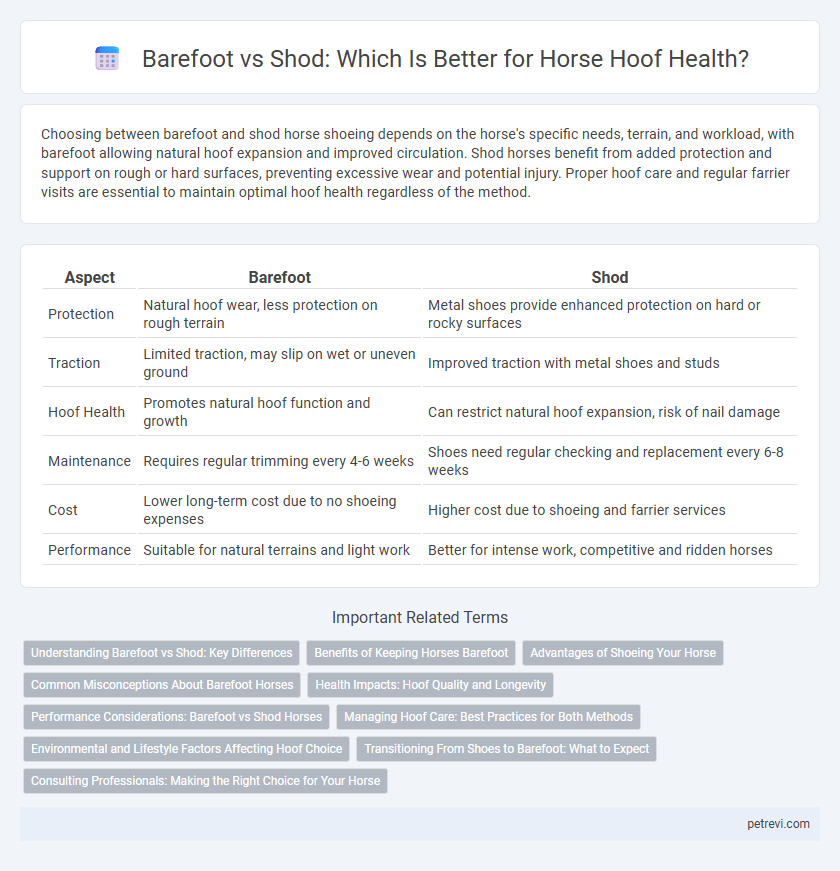Choosing between barefoot and shod horse shoeing depends on the horse's specific needs, terrain, and workload, with barefoot allowing natural hoof expansion and improved circulation. Shod horses benefit from added protection and support on rough or hard surfaces, preventing excessive wear and potential injury. Proper hoof care and regular farrier visits are essential to maintain optimal hoof health regardless of the method.
Table of Comparison
| Aspect | Barefoot | Shod |
|---|---|---|
| Protection | Natural hoof wear, less protection on rough terrain | Metal shoes provide enhanced protection on hard or rocky surfaces |
| Traction | Limited traction, may slip on wet or uneven ground | Improved traction with metal shoes and studs |
| Hoof Health | Promotes natural hoof function and growth | Can restrict natural hoof expansion, risk of nail damage |
| Maintenance | Requires regular trimming every 4-6 weeks | Shoes need regular checking and replacement every 6-8 weeks |
| Cost | Lower long-term cost due to no shoeing expenses | Higher cost due to shoeing and farrier services |
| Performance | Suitable for natural terrains and light work | Better for intense work, competitive and ridden horses |
Understanding Barefoot vs Shod: Key Differences
Barefoot horses rely on natural hoof mechanics, promoting improved circulation and shock absorption, while shod horses benefit from metal shoes that protect hooves on hard or abrasive surfaces and provide traction. Key differences include the barefoot approach favoring natural wear and flexibility versus shod hooves offering enhanced durability and injury prevention during demanding activities. Evaluating terrain, workload, and hoof health is essential in deciding between barefoot and shod care for optimal equine performance and comfort.
Benefits of Keeping Horses Barefoot
Keeping horses barefoot enhances natural hoof function, promoting better circulation and shock absorption essential for overall equine health. Barefoot horses typically experience fewer hoof-related problems such as cracks or infections, reducing veterinary and farrier expenses. This approach supports improved traction on varied terrains and encourages stronger, more resilient hoof growth compared to shod horses.
Advantages of Shoeing Your Horse
Shoeing your horse provides essential hoof protection, reducing wear and tear on hard or rough surfaces and preventing cracks or splits. Metal shoes also offer improved traction, enhancing performance and stability on slippery or uneven terrain. Proper shoeing can correct gait imbalances and support horses with specific hoof or leg conditions, promoting long-term soundness.
Common Misconceptions About Barefoot Horses
Many horse owners mistakenly believe barefoot horses cannot perform at high levels or are more prone to injury, despite evidence showing strong hoof health and natural shock absorption. Proper trimming and hoof care allow barefoot horses to maintain soundness comparable to shod horses, especially on softer terrain. Barefoot horses often benefit from increased circulation and natural hoof function, challenging the misconception that shoes are always necessary for protection and performance.
Health Impacts: Hoof Quality and Longevity
Barefoot horses often exhibit improved hoof quality due to natural wear patterns and enhanced circulation, promoting stronger, more resilient hooves. In contrast, shod horses may experience protection against excessive wear but risk compromised hoof health if shoes restrict natural expansion or trap moisture, leading to conditions like thrush or laminitis. Long-term hoof longevity tends to favor barefoot management when paired with proper trimming and environmental conditions, supporting sustainable hoof integrity and reducing chronic lameness.
Performance Considerations: Barefoot vs Shod Horses
Barefoot horses often exhibit greater natural hoof flexibility and improved circulation, enhancing shock absorption and overall comfort during performance. Shod horses benefit from added protection and traction, which can be crucial on demanding terrains or during high-impact activities, reducing the risk of hoof damage. Performance outcomes depend heavily on the horse's workload, terrain, and individual hoof condition, making personalized hoof care essential for optimal results.
Managing Hoof Care: Best Practices for Both Methods
Managing hoof care requires tailored approaches for both barefoot and shod horses to maintain optimal hoof health and performance. Regular trimming schedules, proper hoof cleaning, and monitoring for signs of wear or injury are essential practices in barefoot management, while shod horses benefit from expert horseshoeing techniques, including correctly fitted shoes and timely replacements to prevent hoof damage. Both methods demand close collaboration between farriers and horse owners to ensure the horse's comfort, durability, and soundness.
Environmental and Lifestyle Factors Affecting Hoof Choice
Environmental factors such as terrain type, climate, and pasture quality play a critical role in deciding between barefoot and shod hoof care for horses. Horses in wet, rocky, or uneven environments often benefit from shoes that protect against excessive wear and improve traction. Conversely, horses living on soft, grassy pastures with regular movement may maintain healthier hooves barefoot, promoting natural wear and circulation.
Transitioning From Shoes to Barefoot: What to Expect
Transitioning from shod to barefoot requires an adjustment period where horses may experience changes in hoof sensitivity and traction, often necessitating gradual exposure to varied terrain. Proper hoof care, including regular trimming and monitoring for signs of discomfort or cracks, is essential during this phase to support natural hoof function and growth. Expect improved hoof health and mechanics over time, but be prepared for a temporary decrease in performance as the horse adapts to barefoot movement.
Consulting Professionals: Making the Right Choice for Your Horse
Consulting equine veterinarians and professional farriers ensures a tailored approach to choosing barefoot or shod hoof care, considering the horse's breed, workload, and hoof health. Experts assess factors like hoof conformation, terrain, and gait to recommend optimal shoeing or barefoot trimming techniques. Regular evaluations by professionals help prevent lameness, maintain hoof integrity, and enhance overall equine performance.
Barefoot vs Shod for Horse Shoeing Infographic

 petrevi.com
petrevi.com